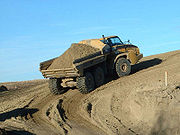
Caterpillar 740 Ejector
Encyclopedia


Caterpillar Inc.
Caterpillar Inc. , also known as "CAT", designs, manufactures, markets and sells machinery and engines and sells financial products and insurance to customers via a worldwide dealer network. Caterpillar is the world's largest manufacturer of construction and mining equipment, diesel and natural gas...
's second generation of articulated hauler
Articulated hauler
An articulated hauler is a type of dump truck used to transport loads over rough terrain. The vehicle usually have all-wheel drive and consists of two basic units, one generally called the tractor and the rear section, called the hauler or trailer section, which contains the dump body...
s (dump truck
Dump truck
A dump truck is a truck used for transporting loose material for construction. A typical dump truck is equipped with a hydraulically operated open-box bed hinged at the rear, the front of which can be lifted up to allow the contents to be deposited on the ground behind the truck at the site of...
) to have a system that pushes material out the back of the body. It is the largest articulated haul truck offered by Caterpillar; larger trucks use a rigid frame system. The ejector uses a 4 cylinder hydraulic ram and blade to dump the material out, a similar system to Cat's wheel tractor-scrapers. The 740 Ejector is sold as separate model from the usual 740.
Total power is 436 hp (325 kW), total operating weight is 162,280 lb (73,610 kg), with the load being 42 short ton
Short ton
The short ton is a unit of mass equal to . In the United States it is often called simply ton without distinguishing it from the metric ton or the long ton ; rather, the other two are specifically noted. There are, however, some U.S...
s (38 tonne
Tonne
The tonne, known as the metric ton in the US , often put pleonastically as "metric tonne" to avoid confusion with ton, is a metric system unit of mass equal to 1000 kilograms. The tonne is not an International System of Units unit, but is accepted for use with the SI...
s), 37.3 yd³ (28.5 m³) at a 1:1 heap. Top forward speed is 34 mph (55 km/h).
History
Caterpillar introduced an ejector version of its D400E in 2001. In 2002/2003, the DX00 series of trucks were replaced with the 7XX range. Currently Caterpillar supplies 725, 730, 730 Ejector, 735, 740 and 740 Ejector versions. The 7XX truck series uses the same cab design across all types. These are all manufactured in the UK.Advantages and disadvantages
Current advantages- Lower risk of tipping over on slopes when dumping.
- Ability to spread the material out over a distance.
- Dumping does not increase the risk of contacting overhead obstacles (power lines, bridges, etc.).
- Virtually eliminate any material remaining in the body after dumping.
- Dumping and returning can be done without slowing down.
Current disadvantages
- Reduction in types of materials suited for hauling, large rocks can wedge between sidewall and ejector causing damage.
- Winter operations may cause wet material to freeze on sidewall jamming ejector.
- More complicated operation, additional parts to maintain.
- Body can be damaged from contact while loading, preventing ejection.
External links
- Caterpillar 740 Ejector - Official Caterpillar website
- Ejector system (image from manufacturer website)
- Magazine Article in Earthmovers Magazine about Maveric Contractors Caterpillar 740 Ejectors

